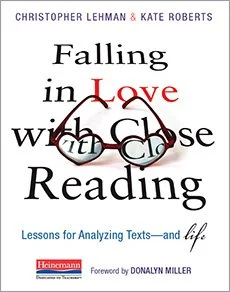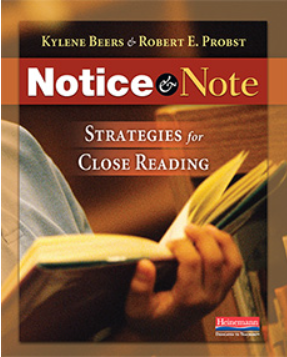Close & pointed reading
Close reading
I draw upon the voices of Christopher Lehman, Kate Roberts, Kylene Beers and Robert (Bob) Probst to define close reading with middle and high school students. Christopher and Kate’s book, Falling in Love with Close Reading: Lessons for Analyzing Texts--and Life offers fabulous ideas for how to coach readers to know when to stop and reflect (closely read) on choices their authors make to in turn grow their own understandings as readers. Kylene and Bob’s book, Notice & Note: Strategies for Close Reading offers ideas of how to closely read smaller sections, carrying that work into other parts of the texts.
I often offer Chris and Kate’s definition of close reading to students so they can understand the why for our work. “Close reading is when a reader independently stops at moments in a text (or media or life) to reread and observe the choices an author has made. He or she reflects on those observations to reach for new understandings that can color the way the rest of the book is read (or song heard or life lived) and thought about.”
I have leaned on the strategies from Notice & Note for many years. I appreciate Kylene and Bob’s explanation of the characteristics of close reading (see page 36). Particularly that it often involves rereading of short portions of a text with intensity, and then bringing ideas from those short rereads to longer sections of the book. That is to say, other than Graduate Students of Comparative Literature, we would almost never require students to reread and closely analyze every page of a text. There is just no time for that in a busy classroom. More importantly, rereading page after page after page is an engagement killer and kids who don’t read don’t learn to read well. We have a choice to teach in ways that either raise engagement and joy or smash it to bits, so we agree it is important to teach students to stop and observe small sections and then jump back into their love affair with the unfolding story or fascination with the ideas of an article.
I believe that close reading is not simply a way to analyze texts. It is a way to study the things that we love more carefully and appreciate their subtleties more fully. Close reading can be applied to texts, but we also can look to songs, video games, television shows, art and even our daily lives. We observe the choices a chef made when our meal is presented to us at the table (“wow, this looks so good… are those mushrooms?”) just as we form interpretations off the little things our partner does (“she is either doing this to make me feel special or because she wants to ask me something…”). Our students deserve to have experiences with close reading not only be “task” driven, but instead be life driven.
pointed reading
I had the gift of experiencing pointed reading during a 2019 NCTE (National Council of Teachers of English) session with Kylene Beers, Bob Probst, Penny Kittle and Linda Rief. We poured over the words of Teresa Palomo Acosta’s poem, “In the Season of Change” in a room with hundreds of other educators from around the world.
We were taken through a process that I have since used and found effective with many middle and high school students. Over time, I have broken the process I lived at NCTE into six phases. Phases 1-3 focus on reading and rereading the short text. Phases 4-6 focus on discussing and trying quick writes to illuminate readers’ perspectives about the text and themselves throughout the pointed reading process. Teachers may chose to live all phases in one period with students or stretch them out over several days.
(T) = teacher & (S) = students
1st read aloud of text by (T) /
(S) follow along with text in hand
2nd read aloud of text by (T) /
(S) underline or highlight at least 5 lines (can include title) that resonate with them (for any reason)
3rd read aloud of text by (T) &
(S) join in with voices on lines/phrases/words they annotated
(T) & (S) discuss what they noticed during phases 1-3
(T) & (S) annotate vocabulary/phrases and discuss choices made by the author to (or not to) define vocabulary
(S) quick write for 3-5 minutes at a time, sharing with partners:
based on the purpose of each quick write
how their writing changed their perspective on the poem and/or their own identity of self
The texts used for pointed reading must be short and engaging. Poems, songs, and excerpts from texts work beautifully.



